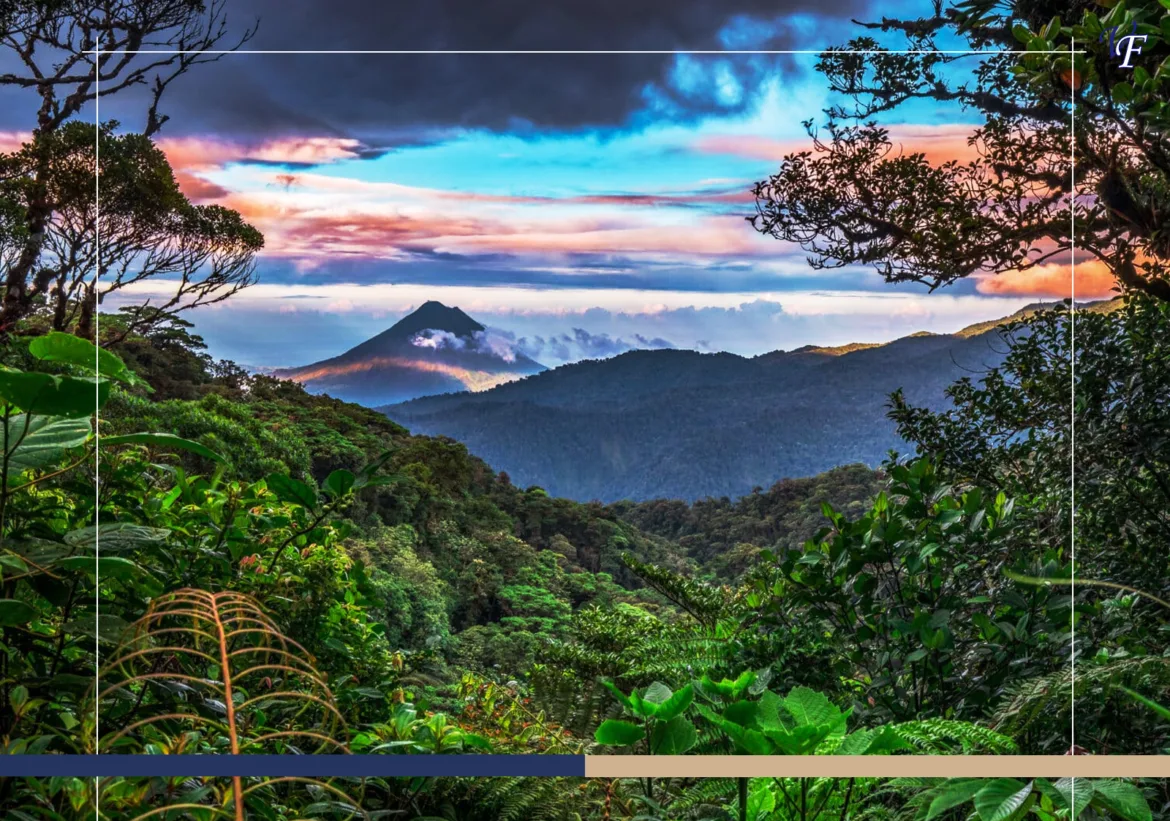Costa Rica has become a must-visit destination for travelers worldwide. Whether you’re a nature enthusiast, an adventure seeker, or someone looking to unwind in tropical serenity, this gem of Central America offers something for everyone.
From the best time to visit to the essentials of Costa Rican etiquette, we’ve got you covered. We understand that planning a trip can be overwhelming, especially to a destination as diverse as Costa Rica. That’s why we’ve compiled this comprehensive guide on the most frequently asked questions about traveling to Costa Rica to help you navigate the ins and outs easily and confidently.
So, whether you’re in the early stages of planning your trip or just dreaming about tropical sunsets and Costa Rican coffee, these Costa Rica Travel FAQs will answer all the questions running through your mind and inspire your journey.

Q. What month is best to visit Costa Rica?
Visiting Costa Rica is a delightful experience at any time of the year. Still, certain months may align better with your travel preferences, depending on whether you’re looking for the best weather, fewer crowds, or lower prices.
Here’s a monthly breakdown to help you decide the best time to visit:
Dry Season (January to April)
- January to March: Peak tourist season with sunny weather and minimal rain. It is ideal for beaches and outdoor exploration, but expect higher prices and crowds.
- April: It marks the end of the dry season, but still has favorable weather with occasional showers and fewer crowds.
Green Season (May to August)
- May to June: Start of the green season with afternoon rain showers. This period is known for the lush landscapes, fewer tourists, and lower prices.
- July: “Veranillo” or mini-dry spell with less rain, making it a pleasant travel time.
- August: There is an increase in rainfall, but mornings are often clear. This month is good for budget travel.
Rainy Season (September to December)
- September to October: There is expected to be a significant amount of rainfall, with the heaviest precipitation occurring on the Pacific coast. The Caribbean side remains drier. There are ample opportunities to witness diverse wildlife in their natural habitats.
- November: The dry season is approaching, so there will be less rainfall and better weather conditions.
- December: The early month offers good weather with fewer tourists before the holiday rush.
In summary, the best time to visit Costa Rica depends on what you’re looking for.
Q. How many days in Costa Rica is enough?
The ideal length of a trip to Costa Rica depends on your interests and the regions you wish to explore. However, here’s a general guideline:
- Short Trip (7-10 Days): Spend your vacation exploring popular places, beaches, and national parks and enjoying a perfect blend of nature, wildlife, and relaxation. You can check out the 10-day Costa Rica itinerary to plan your vacation better.
- Moderate Trip (10-14 Days): Allows a more relaxed pace to visit popular tourist places in Costa Rica. You can experience a good mix of adventure, wildlife, and leisure.
- Extended Trip (14-21 Days or More): Ideal for a comprehensive exploration. You can comfortably travel from the Caribbean coast to the Pacific, including stops in national parks, volcanoes, remote beaches, and cultural sites. This duration is perfect for immersive experiences and off-the-beaten-path adventures.
Q. How much does a trip to Costa Rica cost?
The cost of a trip to Costa Rica can vary greatly depending on travel style, accommodation choices, activities, and the time of year. Here’s a rough estimate:
- Budget Travel: For travelers on a budget, expect to spend $50-70 per day by staying in hostels, using public transportation, and enjoying free activities such as hiking and visiting beaches.
- Mid-Range Travel: Mid-range travelers who stay in standard hotels, rent a car, use private transfers, and participate in paid activities can expect to spend between $100 and $200 daily.
- Luxury Travel: For a luxury experience in an all-inclusive villa, private tours, and gourmet dining, the cost can exceed $300 per day.
Q. Is it safe to travel to Costa Rica right now?
Costa Rica is generally considered a safe destination for travelers, known for its stable political environment and hospitable culture. While it’s a welcoming place for tourists, visitors should be mindful of petty crimes like pickpocketing, especially in crowded or popular tourist areas.
Being one of the most asked Costa Rica Travel Questions, it’s advisable to stay informed about the latest travel advisories, particularly regarding health safety protocols. The country has implemented measures to manage health risks, and travelers should familiarize themselves with entry requirements or local guidelines.
For current updates, consult your government’s travel advisory services before your trip.
Q. What currency is used in Costa Rica?
The official currency of Costa Rica is the Costa Rican Colón (CRC). US Dollars are also widely accepted in most tourist areas, but paying in Colones is generally more economical. Credit cards are commonly accepted in hotels, restaurants, and shops, although smaller establishments and rural areas may require cash. ATMs are readily available in cities and tourist destinations for withdrawing local currency.
Q. Why is Costa Rica popular for tourists?
Costa Rica is popular among tourists for several reasons:
- Biodiversity: Home to an incredible array of wildlife, including exotic birds, monkeys, and sloths, within diverse ecosystems ranging from rainforests to beaches.
- Eco-Tourism: A global leader in eco-tourism, offering sustainable travel experiences for nature lovers and environment-conscious travelers.
- Adventure Activities: Offers a variety of outdoor activities like zip-lining, surfing, hiking, and snorkeling.
- Cultural Experiences: This tropical paradise is rich in culture with friendly locals, vibrant festivals, and delicious cuisine.
- Scenic Beauty: Features stunning landscapes, from pristine beaches to lush rainforests and imposing volcanoes.
These are a few elements that answer the question, “What is Costa Rica known for?.”
Q. Is it safe to drink the tap water in Costa Rica?
Tap water is generally safe to drink in most urban areas of Costa Rica, but it’s advisable to be cautious in rural areas or small communities. While the water quality is high in places like San José and other large cities, travelers with sensitive stomachs may prefer bottled water.
To answer this travel FAQ about the country, always ask locals if tap water is safe in that area.
Q. What languages are spoken in Costa Rica?
The official language of Costa Rica is Spanish. It’s the primary language used for business, government, and daily life. However, English is widely spoken, especially in tourist areas, making communication relatively easy for English-speaking visitors.
Additionally, there are areas where indigenous languages are spoken, and on the Caribbean coast, you might hear local Creole English. Knowing basic Spanish phrases, however, can enhance your travel experience and help you connect more with locals.
Q. What is the best thing to buy in Costa Rica?
When shopping in Costa Rica, there are several unique and memorable items that you can buy as Costa Rica souvenirs or gifts:
- Coffee: Costa Rica is famous for its high-quality coffee, making it a must-buy item for coffee enthusiasts.
- Wooden Crafts: Look for beautifully carved wooden items, including kitchenware, decorative pieces, and traditional oxcarts.
- Chocolates: Costa Rican chocolates are becoming increasingly renowned for their high quality and delicious taste. They make for a delightful treat that many chocolate lovers can enjoy.
- Art: Local art, from paintings to pottery, reflects the country’s rich culture and natural beauty.
- Eco-friendly Products: Costa Rica’s focus on sustainability means you can find a variety of eco-friendly souvenirs here to take home.
Not only are these items great souvenirs, but they also support local artisans and businesses.

Q. What vaccinations do I need to travel to Costa Rica?
Before traveling to Costa Rica, ensure that your routine vaccinations are up to date. These typically include measles-mumps-rubella (MMR), diphtheria-tetanus-pertussis, varicella (chickenpox), polio, and your yearly flu shot. Additionally, the following vaccinations are often recommended:
- Hepatitis A: Recommended for most travelers, as you can get it through contaminated food or water in Costa Rica.
- Hepatitis B: Recommended for those who might have sexual contact with a new partner, get a tattoo or piercing, or have any medical procedures.
- Typhoid: Recommended for travelers visiting smaller cities or rural areas.
It’s always best to consult with a healthcare provider or a travel medicine specialist for the most current advice and recommendations based on your health history and travel itinerary.
Q. What is the tipping etiquette in Costa Rica?
Tipping is appreciated but not always expected in Costa Rica. But there are a few exceptions in the tipping etiquette in Costa Rica:
- Restaurants: A 10% service charge is often included in the bill. You can tip an additional 5-10% if the service is exceptional.
- Taxis: Tipping is not customary, but rounding up the fare is appreciated.
- Tour Guides: For good service, consider tipping $5-10 per day for group tours or 10-15% of the cost for private tours.
- Hotel Staff: For housekeeping, $1-2 per service or per day is a common tip.
Always check your bills to see if a service charge has been added and remember that tipping is a way to show appreciation for good service.
Q. What are the best ways to get around Costa Rica
Getting around Costa Rica offers various options depending on your budget, comfort level, and travel preferences:
- Rental Cars: Ideal for flexibility and exploring at your own pace. 4×4 vehicles are recommended for rural areas.
- Public Buses: An affordable way to travel between cities and popular tourist destinations, though less convenient for remote areas.
- Domestic Flights: Efficient for covering long distances quickly, with several local airlines connecting major destinations.
- Shuttle Services: Shared or private shuttles offer a comfortable and stress-free way to travel between tourist spots.
- Taxis: Widely available in cities and towns; ensure they are official taxis, recognizable by their red color and yellow triangle sticker.
Each mode of transportation offers a different balance of cost, convenience, and the opportunity to explore.
Q. What are the must-try foods in Costa Rica?
Costa Rican food is a blend of flavors and ingredients, offering several must-try dishes:
- Gallo Pinto: A traditional breakfast dish made with rice and beans and often served with eggs, plantains, and sour cream.
- Casado: A typical lunch plate with rice, beans, salad, plantains, and meat or fish.
- Ceviche: Fresh raw fish cured in citrus juices and spiced with chili peppers.
- Tamales: Corn dough stuffed with various fillings like meat, rice, and vegetables, wrapped in banana leaves.
- Arroz con Leche: A sweet rice pudding dessert flavored with cinnamon and raisins.

Q. Do you need a passport to go to Costa Rica?
Yes, a valid passport is required to enter Costa Rica. The passport must be valid for at least six months beyond your expected departure date. Additionally, you may need to show proof of onward or return travel. Visitors from most countries, including the United States, Canada, and European Union nations, do not require a visa for stays of up to 90 days. However, visa requirements can vary, so it’s essential to check the specific requirements for your country before traveling.
We hope this has answered the most common question – Do you need a passport to go to Costa Rica?
In conclusion, Costa Rica offers a captivating journey for travelers seeking natural beauty, adventure, and cultural immersion.
This Costa Rica travel guide has provided insights into the best times to visit, travel essentials, and must-try experiences.
As you plan your trip to this enchanting land, remember that your safety is a priority, and staying informed about travel advisories is essential.
For any other questions about Costa Rica or further assistance, consult your government’s travel advisory services or contact local experts.











